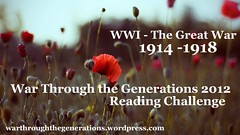The War to End All Wars: World War 1 by Russell Freedman is a collection of historical information about the war enhanced by photos and a good introduction to this part of history for ages 7 and up. Not only does Freedman offer the political, social, and military ins and outs of the build up to WWI, he illustrates the circumstances of the time period through photographs of soldiers in training, women pinning flowers on marching soldiers leaving for war, women plowing the fields without horses, and event the modern weaponry used.
Readers looking for an in-depth examination of the period will want to this book because the photos break up the factual litany and provide a human face behind the story. Some of the surprising pictures for me were of the modern tanks that the British created and the gas masks made for horses. Ironically, the rebels who were the catalyst behind the war had no idea that Archduke Franz Ferdinand was sympathetic to the Serbs cause for greater free and a larger voice in the Austria-Hungary empire. In another section of the book, readers will discover similarities between WWI and the Cold War with the build up of armies and weapons, but unlike during the Cold War, the leaders during WWI were unsuccessful in their attempts at diplomacy even though many of the royal leaders were related.
However, don’t mistake this as a completely dark and dreary book because there are lighter moments depicted where soldiers created a snowman and gave him military gear, including a spiked helmet and Mauser 98 rifle. However, war is far from pretty with the death of comrades from artillery shells to the rampant diseases that quickly spread through the primitive trenches, including trench foot, trench fever spread by bloodsucking lice, and other ailments.
“Added to these indignities was the awful stench that hung over the frontlines, a foul odor that instantly assaulted visitors. You could smell the frontline miles before you could see it. The reek rose from rotting corpses lying in shallow graves, from overflowing latrines, and from the stale sweat of men who had not enjoyed the luxury of a bath for weeks.” (page 68)
To be honest, the photos accompanying the early sections about the serious living conditions these soldiers faced in the trenches are inadequate, but there is little the author could do about that. The images of men caught up in barbed wire in No-Man’s Land or crossing the battlefield in a cloud of poison gas are simply haunting in a way that the numbers of dead (4 million Russian soldiers by the end of 1915) are unfathomable. Modern warfare began during WWI with the manufacture of tanks and German U-boats, which were allegedly responsible for the sinking of the Lusitania in 1915. But the United States did not declare war until 1917 after Germans attacked a number of U.S. ships. There are stunning images of how societies coped with food shortages as trade was disrupted and how people reacted as they were forced to pick up the pieces after soldiers left.
The War to End All Wars: World War 1 by Russell Freedman is a comprehensive look at WWI and all the nations involved, as well as how it impacted not only the societies bombed and destroyed, but also the soldiers. Despite all the destruction, patriotism drove many soldiers and supporters of the war, and it begs the question when does patriotism become a detriment to society and humanity.





